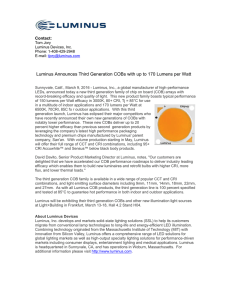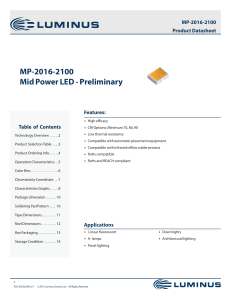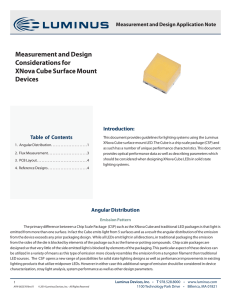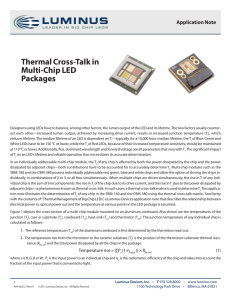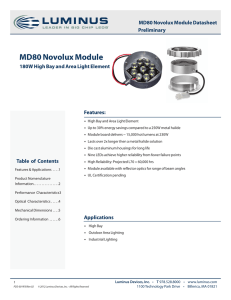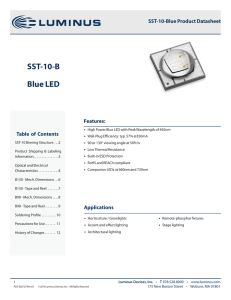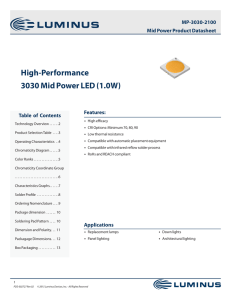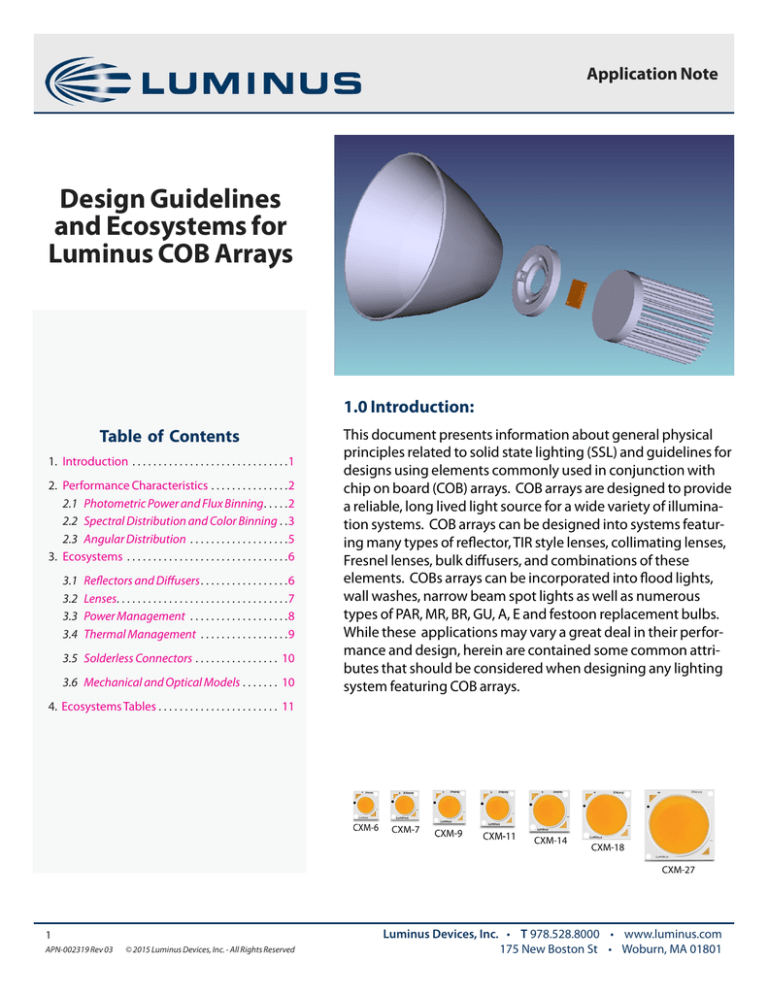
Application Note
Design Guidelines
and Ecosystems for
Luminus COB Arrays
1.0 Introduction:
Table of Contents
1. Introduction . . . . . . . . . . . . . . . . . . . . . . . . . . . . . . 1
2. Performance Characteristics. . . . . . . . . . . . . . . 2
2.1 Photometric Power and Flux Binning. . . . . 2
2.2 Spectral Distribution and Color Binning. . 3
2.3 Angular Distribution . . . . . . . . . . . . . . . . . . . 5
3. Ecosystems . . . . . . . . . . . . . . . . . . . . . . . . . . . . . . . 6
3.1
3.2
3.3
3.4
Reflectors and Diffusers. . . . . . . . . . . . . . . . . 6
Lenses. . . . . . . . . . . . . . . . . . . . . . . . . . . . . . . . . 7
Power Management . . . . . . . . . . . . . . . . . . . 8
Thermal Management . . . . . . . . . . . . . . . . . 9
3.5 Solderless Connectors. . . . . . . . . . . . . . . . . 10
3.6 Mechanical and Optical Models. . . . . . . . 10
This document presents information about general physical
principles related to solid state lighting (SSL) and guidelines for
designs using elements commonly used in conjunction with
chip on board (COB) arrays. COB arrays are designed to provide
a reliable, long lived light source for a wide variety of illumination systems. COB arrays can be designed into systems featuring many types of reflector, TIR style lenses, collimating lenses,
Fresnel lenses, bulk diffusers, and combinations of these
elements. COBs arrays can be incorporated into flood lights,
wall washes, narrow beam spot lights as well as numerous
types of PAR, MR, BR, GU, A, E and festoon replacement bulbs.
While these applications may vary a great deal in their performance and design, herein are contained some common attributes that should be considered when designing any lighting
system featuring COB arrays.
4. Ecosystems Tables. . . . . . . . . . . . . . . . . . . . . . . . 11
1
APN-002319 Rev 03
© 2015 Luminus Devices, Inc. - All Rights Reserved
Luminus Devices, Inc. • T 978.528.8000 • www.luminus.com
175 New Boston St • Woburn, MA 01801
COB -Application
Testing Big Chip LEDsApplication Note
2.0 Performance Characteristics
2.1 Photometric Power and Flux Binning
The amount of illumination a lighting system can provide as well as the intensity of the beam it creates is directly
proportional to the photometric power, or luminous flux produced by the light source. Luminous flux is measured in units of
lumens and is the rate of energy radiated per unit time by the
light source within the range of visible wavelengths. Lumens
are calculated by integrating the product of the radiometric
power per unit wavelength of the source (often referred to as
the spectral response function or spectral distribution) and the
human visual response curve (Fig. 1. ) The human visual response curve (often referred to as the C.I.E. photopic response
curve) is an experimentally derived function based on the
perceptions of light by human subjects over a range of intensities and colors. The data were produced and are maintained by
the Commission International l’Eclairage (C.I.E.), an international standardization organization whose protocols have become
standard in the lighting industry. The mathematical relationship
can be expressed as follows where S(λ) represents the spectral
distribution and ȳ(λ) represents the photopic response curve.
Fig. 1 CIE Photopic Response Curve
Luminous Flux = ∫ S(λ)• ȳ(λ)•dλ
This integral is calculated from a range of 380nm to
730nm since it is in this wavelength range that the typical
human observer is capable of perceiving light energy. This
result assumes the radiation is emitted in all directions which
can be described by spherical surface area surrounding the
Fig. 2 Integrating Sphere
source.
Physically, luminous flux is typically measured in an integrating sphere (Fig. 2. ) An integrating sphere
is a device which uses a spherical chamber coated on the inside with a material that is highly reflective and
incurs very little absorptive loss when light from the source under test strikes it. The light is reflected back
and forth within the sphere many, many times before it eventually falls on a detector. In this manner the light
from the source is “integrated” and any directional component inherent to the source is removed. As a result
the integrating sphere returns a measurement of the total flux as if it were emitted in all directions (like an
Edison light bulb) even if the emission of the source is highly directional (like an LED coupled with a dome
lens.)
The process of manufacturing LEDs results in devices that produce a range of luminous flux for a
given drive current. For this reason finished parts are tested then sorted into bins based on their luminous
flux at their rated drive current. Binning insures that designers are able to obtain a predictable output from
the light source in their system. It also provides a measure of uniformity in across light sources if numerous
LEDs are used in a system. The binning structure for each device is described in detail in the data sheet for
each COB product.
2
APN-002319 Rev 03
© 2015 Luminus Devices, Inc. - All Rights Reserved
Luminus Devices, Inc. • T 978.528.8000 • www.luminus.com
175 New Boston St • Woburn, MA 01801
COB-Application
Testing Big Chip LEDsApplication Note
2.2 Spectral Distribution and Color Binning
LEDs produce light by means of a quantum mechanical process known as electroluminescence. This
occurs when electrons move from one type of semi-conductor material to another. This movement happens
when a voltage is applied across the two materials. Chemical dopants are added to the materials in order to
facilitate the combination of electrons donated from one material with energy voids called holes in the other.
Materials that contain an excess of electrons and thus contain an inherent negative bias are referred to as “N”
type materials. Conversely materials that are apt to receive electrons and therefore have an inherent positive
bias are called “P” type materials.
Any solid state diode, either light emitting or otherwise, requires the combination of P and N type
materials. When a voltage is applied across the N and P materials, electrons and holes begin gathering in a
region called the depletion layer and they combine at what is known as the junction. When the electrons combine with holes they emit a quantum of light known as a photon. Even in low output indicator LEDs billions and
billions of holes and electrons are combining every second. Since there is a range of energies at which the
electron-hole combination may occur, the light emitted by the LED also occurs across a range of wavelengths.
This range is referred to as the spectral response or spectral emission.
Fig. 3 Pumped Phosphor Spectral Distribution
By themselves doped semiconductor
LEDs produce light that is perceived as a
highly pure, saturated color. There are two
methods by which LED devices produce white
light. Individual red, green and blue LEDs may
be assembled in a package small enough so
that the combined emission appears as white
light. This method has advantages in applications where it might be desirable to have the
ability to change the color of the lighting such
as in entertainment or photographic lighting.
However in general lighting where high
efficiencies are a more important performance parameter, LEDs are packaged with
phosphors, either deposited directly on the
LED die or remotely on a cover or lens.
In this arrangement the LED die “pumps” the phosphor and the phosphor emits light across a much wider
emission band than the LED alone (Fig. 3.) Since phosphors produce light as a result of the internal molecular arrangement of the phosphor itself, no additional energy is required other than the radiated
emission coming from the LED pump.
The spectral characteristics (i.e. color) of pumped phosphor LEDs will depend on the combination
of the LED die used as a pump and the formulation of the phosphor packaged with it. Phosphors can be
formulated to produce a wide variety of colors including many types of white light. White light is characterized by where it falls along the blackbody curve (Fig 4.) While pumped phosphor LEDs do not emit
3
APN-002319 Rev 02
© 2015 Luminus Devices, Inc. - All Rights Reserved
Luminus Devices, Inc. • T 978.528.8000 • www.luminus.com
175 New Boston St • Woburn, MA 01801
COB-Application Note
2.2 Spectral Distribution and Color Binning Cont.
light in the same way that blackbody radiators do (such as a bar of iron that is heated until it glows) their emission
can be characterized in terms of the equivalent temperature that a blackbody radiator would have to reach in
order to produce the same color of white light. Thus white LEDs are characterized in terms of what is known as
“correlated color temperature (CCT)” which is given in units of degrees Kelvin.
Luminus COB arrays are binned within a range of colors which can be described on a virtual area known as
color space. In 1931 the C.I.E. published a methodology for assigning a value to colors based on a set of coordinates within a two dimensional color space. The area is referred to as the CIE 1931 Chromaticity Diagram (Fig. 4.)
This area provides a mathematical methodology for locating a given color within the color space. The x,y
chromaticity coordinates of the color produced by an emissive or reflective source are derived by solving mathematical integrals weighted by the color response of a typical human observer.
The degree to which a human observer can
differentiate one color, or shade of color, from another
can be represented by elliptical areas of varying sizes on
the 1931 chromaticity diagram. The MacAdam ellipse is a
series of regions on the 1931 diagram that are used to
describe how closely related a given set of points on the
chromaticity diagram will appear to a standard observer.
Since human vision is better at differentiating colors in
greens and yellows (480 to 580nm,) and less sensitive to
blues and purples (380 to 480nm), standard MacAdam
ellipses vary in size throughout CIE 1931 color space. For
white light binning of LEDs, these MacAdam ellipses fall
along the blackbody curve according to the specified
color temperature.
The total area covered by a MacAdam ellipse is
referred to as the step size. Each step represents a standard deviation of the major and minor axis of the ellipse
based on a statistical sample. Each standard deviation is
based on the ability of a standard observer to differentiate a color difference.
Fig. 4 1931 C.I.E. Chromaticity Diagram
COBs are binned according to two-step, three and five step MacAdam ellipses. To put this into perspective, a one-step MacAdam ellipse is defined as a range of chromaticity coordinates that is impossible for a standard observer to distinguish from one another. This binning structure allows designers a range of options when
considering their color uniformity requirements.
In the binning of white LEDs, MacAdam ellipses are often shown in the context of areas on the 1931 CIE
chart called ANSI quarangles (Fig 5.) The American National Standards Institute (ANSI) has provided a binning
structure based on a 5 step MacAdam ellipse. Ellipses along the blackbody curve may have regions that are
4
APN-002319 Rev 03
© 2015 Luminus Devices, Inc. - All Rights Reserved
Luminus Devices, Inc. • T 978.528.8000 • www.luminus.com
175 New Boston St • Woburn, MA 01801
COB-Application Note
not covered by adjacent ellipses centered at
commonly specified color temperatures. So in order to
improve the efficiency of the binning process,
quadrangles provide a means of insuring that any LED
falls into some particular bin (Fig 5.) Another way of characterizing white LEDs
relates to how colors appear when illuminated by the
white LED. Objects that do not themselves emit light
can be seen because they are reflecting light provided
by some illuminant. Therefore the color of that object
may vary in appearance depending on the spectral
characteristics of the illuminant. The accuracy with
which the color of an illuminated object appears
compared to that same object illuminated by a
standard illuminant is known as the color rendering
index (CRI.) Light sources that score a higher number
on the color rendering index (high CRI) will provide
illumination that causes objects to appear similar to
some referenced color the Munsell hue/chroma scale.
The Munsell scale assigns values based on how that
color would appear in daylight. Higher CRI
illumination light sources have ergonomic benefits for
task lighting however low CRI illuminants can be
advantageous for higher contrast or overall lumen
output.
Fig. 6 Typical Angular Distribution Pattern for CXM Array
5
APN-002319 Rev 03
© 2015 Luminus Devices, Inc. - All Rights Reserved
Fig. 5 MacAdam ellipses and ANSI quadrangles
2.3 Angular Distribution
Luminus COB arrays emit light in what is called a
Lambertian pattern. As Lambertian emitters the
intensity relative to viewing angle very nearly
approximates a cosine curve where the maximum
occurs at 0o (normal) viewing angle (Fig 6.) This results
from the high degree of randomization to the emission
angle of photons released by both the LED die and the
phosphor. The highest intensity of light emission
occurs at a 0o because it is at this angle that emitted
photons are less likely to be reabsorbed by materials in
the system. Photons emitted at high angles relative to
normal must travel through more material, either in the
LED die itself, or through the phosphor layer or in the
packaging material such as the yellow resin. Consequently they are more likely to be
absorbed and converted to heat energy in a process
known as quenching. The data sheet for each COB
product will contain a plot describing the angular
distribution for that device (Fig 6.) It is important to
note that while the absolute intensity of the device will
increase with increased drive current, the relative
intensity vs. viewing angle curve will remain the same
at any drive current.
Luminus Devices, Inc. • T 978.528.8000 • www.luminus.com
175 New Boston St • Woburn, MA 01801
COB-Application Note
Fig. 8 Diagram of Goniometer Used for Far Field Angular
Distribution Measurements:
COB device is mounted on a heatsink and power is applied. A
photodectector is rotated over the device by means of a
motion controlled stepper motor. Radiometric power
readings are recorded by the photodetector at each angular
position throughout a specified range of angles.
3.0 Ecosystems
Designers who choose Luminus COB products can count on reliable, predictable performance from their
light source. In order to utilize the power of COB arrays designers will also need to combine the light source with
numerous optical and electronic elements. A typical solid state lighting system will require at the very minimum
an electrical design, a mechanical design, a thermal design, and an optical design. The particulars of the design
will depend on a number of parameters including the required illumination at various distances, beam angle,
power limitations, ambient environment temperature just to name a few.
In order to provide resources to designers using COB products, Luminus Devices has teamed with Certified
Solution Partners. Our Certified Solution Partners are manufacturers and distributers of equipment necessary to
develop solid state lighting systems based around COB products. Listed in section 3.7 Ecosystems at a Glance are
a wide variety of options for design solutions across many different lighting applications. The Preceding sections
3.1 through 3.6 provide a very general description of how these options may be applied in SSL systems.
3.1 Reflectors and Diffusers
In any application, a reflector is designed to redirect light that is emitted at directions where it is not useful,
to directions where it is useful. Since COB arrays emit light in a Lambertian pattern, a reflector is required in
applications that demand a beam narrower than 180o. The most common types of reflector geometry used in SSL
systems are parabolic, hyperbolic, elliptical zonal. Each of these geometries is suited for particular illumination
patterns.
For example parabolic reflectors typically generate a narrow
beam pattern and hyperbolic reflectors produce a wider beam. Elliptical
reflectors work by placing the light source at one focus of the ellipse
which then concentrates the light down to a point located at the other
focus of the ellipse.
In terms of performance reflectors are characterized in two ways,
their beam width and their beam efficiency. Beam width simply
describes the angular distribution of the light emerging from the system.
6
APN-002319 Rev 03
© 2015 Luminus Devices, Inc. - All Rights Reserved
Luminus Devices, Inc. • T 978.528.8000 • www.luminus.com
175 New Boston St • Woburn, MA 01801
COB-Application Note
A reflector’s efficiency describes how much light from the source is directed into the beam at a particular
angle. Lighting designers specify reflector efficiency in units of candelas per lumen (cd/lm.) The candela is the base
unit of photometry and is defined as 1 lumen per steradian and quantifies the intensity of beam of light emanating from a source. The definition of the candela can also be stated as photometric power per solid angle. So
a reflector’s efficiency can be thought of as the ratio of how many lumens end up in the beam to how many lumens
are provided by the source per degree of solid angle. For this reason the beam efficiency will change over the
angular distribution of the beam. Typically the beam efficiency is specified at the 0o viewing angle.
Typical categories used in general lighting are spot, flood and medium. These categories are defined by the
width of the beam produced by the combination of light source and reflector. Typically this definition depends on
the angular width of the beam at 50% of maximum intensity. Again the metric of “full width at half maximum”
(FWHM) is used however this definition is not to be confused with the FWHM of the intensity vs. wavelength
description of the LED’s spectral distribution.
To some degree, all materials scatter light in various directions as photons travel through. Diffusers are
materials used in lighting systems that are particularly suited for serving this function. Diffusers help to “soften”
lighting by directing light in random directions which results in a wider dispersion of light, and a less defined
appearance to the lighting source. Diffusers also come at a significant cost to the lumens budget of the lighting
system. However designers often deem this cost worthwhile in order to improve the appearance and visual appeal
of the lighting.
3.2 Lenses
A lens is an optical element that uses curved
surfaces to refract light. They can be made of glass or
plastic and in very high performance applications lenses
made of quartz or sapphire may be employed. There are
an immense variety of lenses suited for a host of
applications. Lenses are most commonly used in imaging
systems such as cameras and projectors but are also used
in many types of illumination system. In SSL systems
lenses are often used to concentrate light into a narrow
beam where all the rays emerging from the system are
nearly parallel. This process is known as collimating and
can be useful when the application requires a highly
controlled light. Parabolic reflectors can produce beams
as narrow as 8o to 12o but typically a lens is required to
produce collimated light. Lenses can also be used to
perform the opposite function and disperse light over a
wide area of illumination. The performance of the lens
and beam it produces will depend on several factors such
as the focal length, diameter and thickness of the lens as
well as the position of the lens relative to the light source.
In some systems combinations of lenses are used in order
to produce the desired illumination pattern.
7
APN-002319 Rev 03
© 2015 Luminus Devices, Inc. - All Rights Reserved
Luminus Devices, Inc. • T 978.528.8000 • www.luminus.com
175 New Boston St • Woburn, MA 01801
COB-Application Note
All lenses come with a cost to the optical power of the system. Even lenses equipped with thin
film coatings designed to improve light transmission will incur at a very minimum a 2% loss due to reflection at
each surface to the initial lumens provided by the light source. Furthermore, lenses can be affected by
interference effects or geometric imperfections that may introduce unwanted artifacts such as hot spots, rings,
or non-uniform illumination.
Compound Lenses are arrays of smaller lenses arranged in such a way as to correct for aberrations and
defects that may occur in simpler lenses. One type of compound lens commonly used with LEDs is the so called
total internal reflection (TIR) lens. TIR lenses are typically only used in SSL applications because LEDs offer much
more flexibility for thermal management than any other light source. Since LEDs produce far less heat that
incandescent lights sources, and most of the heat an LED does produce can be made to flow in the opposite
direction of light emission, optical elements can be placed in very close proximity to the source without
degradation to the optic or the source. In many cases the TIR lens completely envelopes the light source. In so
doing TIR lenses act as both reflector and lens as they gather up a very high percentage of emitted light and like
a fiber optic cable guide the light into the desired direction. TIR lenses have another significant advantage in
that total internal reflection is 100% efficient and does not incur any absorptive loss at the reflective surfaces.
Light that is internally reflected within the TIR lens exits through the output face which is often made up of
many small shaped surfaces forming the compound lens.
3.3 Power Management
To emit light a direct current (DC) must flow through the LED. If an AC voltage is applied across the LED if
will not only fail to produce light but it will also be likely to suffer permanent damage. In order to maximize the
efficiency of an electrical grid, AC power must be distributed at voltages that are destructive to LEDs. So for SSL
systems to function properly there must be some electronic interface between the AC power lines and the LEDs
that converts the current from AC to DC and also steps the voltage down to a level that is safe for the LED.
There are two general types of power supplies used in lighting; constant voltage and constant current. In
incandescent and fluorescent lighting systems, power supplies must hold a constant voltage across the terminals
of the light source in order to produce consistent lighting. However LEDs produce light in a very different manner.
LEDs generate light as electrons and holes combine within the molecular lattice of the semiconductor material.
Since electrical current is nothing more than the flow of electrons, in order for the amount of light to remain
consistent, the power supply must deliver a constant current to the LED.
8
APN-002319 Rev 03
© 2015 Luminus Devices, Inc. - All Rights Reserved
Luminus Devices, Inc. • T 978.528.8000 • www.luminus.com
175 New Boston St • Woburn, MA 01801
COB-Application Note
Designers who want the greatest amount of flexibility and customization in their electronic interface will
design their own power supply around a particular integrated circuit (IC.) Functions such as dimming, timing,
temperature monitoring, and fault detection can be based on the parameters of a particular IC. Since this chip
ultimately controls the performance of the lighting source, they are often referred to as LED driver IC’s.
An LED driver board typically contains a driver IC assembled on a circuit board along with other control
and interface components. So the functions of a driver board are particular to a design based around the driver IC
used on that driver board. However driver boards do not come potted or mounted in a frame or fixture which
allows designers a wider range of choices for the mechanical design of their SSL system.
A lighting ballast consists of a driver board along with a housing and interface connectors. A ballast serves
as an off the shelf interface between the source power and the output to the LED. A ballast requires minimal
design or assembly after purchase however few if any modifications or customizations can be made to the part.
3.4 Thermal Management
Two processes occur within an operating LED that result
in the production of heat energy. The first is the result in
collisions between flowing electrons and atoms bound within
the semiconductor materials. Semiconductors like LEDs could
also be termed “semiresistors” and while their resistivity is low
compared to materials like ceramic, they do result in a small
voltage drop across the terminals and therefore produce some
heat. However most of the heat produced by the LED emanates
from the junction as electrons and holes combine. In this small
area heat generation can be very large and if not managed
properly can lead to a significant drop off in light production
and eventual failure of the device. LEDs are packaged so that
heat produced in the junction can be drawn away from the junction and dissipated elsewhere in order to allow the continued operation of the device. COB products are
packaged with an aluminum core board that serves as the first means of drawing heat away from the junctions
within each LED in the array. However by itself the core board is not sufficient to keep the LEDs within the range of
safe operating temperatures.
In order for heat energy to move from the junction to the heat sink and interface material must be used in
order to eliminate thermally resistive air gaps that occur on a microscopic scale. A thermal interface material (TIM)
fills in voids that arise due to the surface roughness and contours of the COB and heat sink. A thermal interface
material increases the surface contact by a significant degree and thereby allows for the efficient removal of heat
from the LED package. All COB products require an effective TIM in order to function properly. The TIM should
contact the entire back surface of the aluminum core board. Likewise the otherside of the TIM should be in
complete contact with he heatsink. Voids, poor adhesion, or insufficient amount of TIM can result in low light
output and failure of the device.
9
APN-002319 Rev 03
© 2015 Luminus Devices, Inc. - All Rights Reserved
Luminus Devices, Inc. • T 978.528.8000 • www.luminus.com
175 New Boston St • Woburn, MA 01801
COB-Application Note
Once heat is removed from the LED package, it must be dissipated quickly and efficiently in order to
prevent the junction temperature from rising to levels that could be destructive to the device. In SSL systems
this function is served by the heat sink. Due to cost and manufacturability, aluminum is the most commonly
used material for heat sinking of LEDs. Heat sinks are often formed into rays or fans in order to maximize the
surface area of the heat sink within a certain volume and mass of material. A passive heatsink relies only on
overall mass and surface area to remove heat from the LED package and dissipate the heat out into the
environment. Active heat sinks use additional means such as a fan or thermo-electric cooler to perform these
functions. Designers can calculate the junction temerature based on the thermal conductivity and thermal
dissapation of the heat sink. For additional information for calculating junction temperature based on
heatsink temperature, see APN-001443 Thermal Management of Big Chip LEDs
3.5 Solderless Connectors
As a requirement for proper operation, COB arrays must be
firmly affixed so that at no time the core board separates from the
TIM and heat sink. There are numerous methods by which this may
be accomplished. The aluminum core board of each COB product is
provided with two through holes for the purpose of mounting the
device in the SSL system. The through holes can be used to either
pass screws or receive holder pins in a holder, clamp or solderless
connector. Section 4 below contains further information for handling and mounting requirements related to solderless connectors.
3.6 Mechanical and Optical Models
Fig. 8 Reference Plane for Optical Models
10
APN-002319 Rev 03
© 2015 Luminus Devices, Inc. - All Rights Reserved
Many designers of SSL systems utilize 3D modeling
software in order to virtually assemble their lamp, bulb or
luminaire and simulate its performance. Virtual modeling
provides a fast an inexpensive way of making changes to
design iterations without having to wait for new prototypes to be built. Luminus Devices provides raytrace files
for COB arrays in formats suitable for commonly used
optical modeling software like Light Tools, Zemax and
Trace Pro. Also provided are solid model files in .iges format
which can be used by programs such as Solid Works and
Pro Engineer. The files can be downloaded from the Resource Center section of the Luminus web site and can be
accessed at the following URL:
http://www.luminus.com/resource/design.html
Luminus Devices, Inc. • T 978.528.8000 • www.luminus.com
175 New Boston St • Woburn, MA 01801
COB-Application Note
4.0 Ecosystem Tables
4.1 Secondary Optics
COB/Reflector/Connector Compatibility Table
Manufacturer
COB p/n
Manufacturer
Reflector p/n
Diameter
(mm)
Height
(mm)
Manufacturer
Connector/Holder
p/n
Luminus Devices
CXM/CLM/CHM-6
Ledil
CN13130_Mirella-50-SDL-PF
49.9
23.9
Ledil
C13083_PF_Socket
Luminus Devices
CXM/CLM/CHM-6
Ledil
CN13131_Mirella-50-MDL-PF
49.9
23.9
Ledil
C13083_PF_Socket
Luminus Devices
CXM/CLM/CHM-6
Ledil
CN13132_Mirella-50-XWPF
49.9
23.9
Ledil
C13083_PF_Socket
Luminus Devices
CXM/CLM/CHM-6
LedLink
LL01CIOT-24R2-P
50
30
LedLink
LL01A00SULB2
Luminus Devices
CXM/CLM/CHM-6
LedLink
LL01CIOT-33R3-P
50
30
LedLink
LL01A00SULB2
Luminus Devices
CXM/CLM/CHM-6
LedLink
LL01CIOT-45R3-P
50
30
LedLink
LL01A00SULB2
49.9
23.9
Ledil
C13083_PF_Socket
Luminus Devices
CXM-7
Ledil
CN13130_Mirella-50-SDL-PF
Luminus Devices
CXM-7
Ledil
CN13131_Mirella-50-MDL-PF
49.9
23.9
Ledil
C13083_PF_Socket
Luminus Devices
CXM-7
Ledil
CN13132_Mirella-50-XWPF
49.9
23.9
Ledil
C13083_PF_Socket
Luminus Devices
CXM-7
LedLink
LL01CIOT-24R2-P
50
30
LedLink
LL01A00SULB2
Luminus Devices
CXM-7
LedLink
LL01CIOT-33R3-P
50
30
LedLink
LL01A00SULB2
Luminus Devices
CXM-7
LedLink
LL01CIOT-345R3-P
50
30
LedLink
LL01A00SULB2
Luminus Devices
CXM-7
LedLink
LL01ED-AKY24R49
50
30
LedLink
LL01A01STYB2
Luminus Devices
CXM-7
LedLink
LL01ED-AKY38R49
50
30
LedLink
LL01A01STYB2
Luminus Devices
CXM-7
LedLink
LL01ED-AKY55R49
50
30
LedLink
LL01A01STYB2
Luminus Devices
CXM-7
Molex
180555-0001
Luminus Devices
CXM-9
Ledil
CN13130_Mirella-50-SDL-PF
49.9
23.9
Ledil
C13083_PF_Socket
Luminus Devices
CXM-9
Ledil
CN13131_Mirella-50-MDL-PF
49.9
23.9
Ledil
C13083_PF_Socket
Luminus Devices
CXM-9
Ledil
CN13132_Mirella-50-XWPF
49.9
23.9
Ledil
C13083_PF_Socket
Luminus Devices
CXM-9
Ledlink
LLO1CIOT-20R2-P
50
30
LedLink
LL01A00SULB2
Luminus Devices
CXM-14
Ledil
F13659_Angelina-S
82
36.04
TE Connectivity
2213130-2
Luminus Devices
CXM-14
Ledil
F13379_Angelina-M
82
36.04
TE Connectivity
2213130-2
Luminus Devices
CXM-14
Ledil
F13381_Angelina-W
82
36.04
TE Connectivity
2213130-2
Luminus Devices
CXM-14
Ledil
F13379_Angela-S
119.5
79.31
TE Connectivity
2213130-2
Luminus Devices
CXM-14
Ledil
F13380_Angela-M
119.5
79.31
TE Connectivity
2213130-2
Luminus Devices
CXM-14
Ledil
F13664_Angela-W
119.5
79.31
TE Connectivity
2213130-2
Molex
180414-0001
Luminus Devices
CXM-14
Luminus Devices
CXM-14-AC00/CHM-9XH00/CXM-11-XH00
Ledil
F13659_Angelina-S
82
36.04
TE Connectivity
2213254-1
Luminus Devices
CXM-14-AC00/CHM-9XH00/CXM-11-XH00
Ledil
F13379_Angelina-M
82
36.04
TE Connectivity
2213254-1
Luminus Devices
CXM-14-AC00/CHM-9XH00/CXM-11-XH00
Ledil
F13381_Angelina-W
82
36.04
TE Connectivity
2213254-1
11
APN-002319 Rev 03
© 2015 Luminus Devices, Inc. - All Rights Reserved
Luminus Devices, Inc. • T 978.528.8000 • www.luminus.com
175 New Boston St • Woburn, MA 01801
COB-Application Note
COB/Reflector/Connector Compatibility Table
Manufacturer
COB p/n
Manufacturer
Reflector p/n
Diameter
(mm)
Height
(mm)
Manufacturer
Connector/Holder
p/n
Luminus Devices
CXM/CLM/CHM-6
Ledil
CN13130_Mirella-50-SDL-PF
49.9
23.9
Ledil
C13083_PF_Socket
Luminus Devices
CXM/CLM/CHM-6
Ledil
CN13131_Mirella-50-MDL-PF
49.9
23.9
Ledil
C13083_PF_Socket
Luminus Devices
CXM/CLM/CHM-6
Ledil
CN13132_Mirella-50-XWPF
49.9
23.9
Ledil
C13083_PF_Socket
Luminus Devices
CXM/CLM/CHM-6
LedLink
LL01CIOT-24R2-P
50
30
LedLink
LL01A00SULB2
Luminus Devices
CXM/CLM/CHM-6
LedLink
LL01CIOT-33R3-P
50
30
LedLink
LL01A00SULB2
Luminus Devices
CXM/CLM/CHM-6
LedLink
LL01CIOT-45R3-P
50
30
LedLink
LL01A00SULB2
49.9
23.9
Ledil
C13083_PF_Socket
Luminus Devices
CXM-7
Ledil
CN13130_Mirella-50-SDL-PF
Luminus Devices
CXM-7
Ledil
CN13131_Mirella-50-MDL-PF
49.9
23.9
Ledil
C13083_PF_Socket
Luminus Devices
CXM-7
Ledil
CN13132_Mirella-50-XWPF
49.9
23.9
Ledil
C13083_PF_Socket
Luminus Devices
CXM-7
LedLink
LL01CIOT-24R2-P
50
30
LedLink
LL01A00SULB2
Luminus Devices
CXM-7
LedLink
LL01CIOT-33R3-P
50
30
LedLink
LL01A00SULB2
Luminus Devices
CXM-7
LedLink
LL01CIOT-345R3-P
50
30
LedLink
LL01A00SULB2
Luminus Devices
CXM-7
LedLink
LL01ED-AKY24R49
50
30
LedLink
LL01A01STYB2
Luminus Devices
CXM-7
LedLink
LL01ED-AKY38R49
50
30
LedLink
LL01A01STYB2
Luminus Devices
CXM-7
LedLink
LL01ED-AKY55R49
50
30
LedLink
LL01A01STYB2
Luminus Devices
CXM-9
Ledil
CN13130_Mirella-50-SDL-PF
49.9
23.9
Ledil
C13083_PF_Socket
Luminus Devices
CXM-9
Ledil
CN13131_Mirella-50-MDL-PF
49.9
23.9
Ledil
C13083_PF_Socket
Luminus Devices
CXM-9
Ledil
CN13132_Mirella-50-XWPF
49.9
23.9
Ledil
C13083_PF_Socket
Luminus Devices
CXM-9
Ledlink
LLO1CIOT-20R2-P
50
30
LedLink
LL01A00SULB2
Luminus Devices
CXM-14
Ledil
F13659_Angelina-S
82
36.04
TE Connectivity
2213130-2
Luminus Devices
CXM-14
Ledil
F13379_Angelina-M
82
36.04
TE Connectivity
2213130-2
Luminus Devices
CXM-14
Ledil
F13381_Angelina-W
82
36.04
TE Connectivity
2213130-2
Luminus Devices
CXM-14
Ledil
F13379_Angela-S
119.5
79.31
TE Connectivity
2213130-2
Luminus Devices
CXM-14
Ledil
F13380_Angela-M
119.5
79.31
TE Connectivity
2213130-2
Luminus Devices
CXM-14
Ledil
F13664_Angela-W
119.5
79.31
TE Connectivity
2213130-2
Luminus Devices
CXM-14-AC00/CHM-9XH00/CXM-11-XH00
Ledil
F13659_Angelina-S
82
36.04
TE Connectivity
2213254-2
Luminus Devices
CXM-14-AC00/CHM-9XH00/CXM-11-XH00
Ledil
F13379_Angelina-M
82
36.04
TE Connectivity
2213254-2
Luminus Devices
CXM-14-AC00/CHM-9XH00/CXM-11-XH00
Ledil
F13381_Angelina-W
82
36.04
TE Connectivity
2213254-2
Luminus Devices
CXM/CHM-18
LedLink
LL01ED-AKA60R49
85
23.5
LedLink
LL01A01STZB2
Luminus Devices
CXM/CHM-18
LedLink
LL01ED-AKX24R49
116
32
LedLink
LL01A01STZB2
12
APN-002319 Rev 03
© 2015 Luminus Devices, Inc. - All Rights Reserved
Luminus Devices, Inc. • T 978.528.8000 • www.luminus.com
175 New Boston St • Woburn, MA 01801
COB-Application Note
COB/Reflector/Connector Compatibility Table
Manufacturer
Connector/Holder
p/n
32
LedLink
LL01A01STZB2
111
85.6
Ledil
C12153_LENA-STDBASE
CN12722_Lena-M-DL
111
85.6
Ledil
C12153_LENA-STDBASE
CN12723_Lena-W-DL
111
85.6
Ledil
C12153_LENA-STDBASE
CXM/CHM-18/CHM14-XH00
Bender & Wirth
453
Luminus Devices
CXM-27
Bender & Wirth
454
Luminus Devices
CXM-9
Bender & Wirth
461
Luminus Devices
CXM/CHM-18/CHM14-XH00
LedLink
LL01A00BVFB2-M2
Diameter Height
(mm)
(mm)
Manufacturer
COB p/n
Manufacturer
Reflector p/n
Luminus Devices
CXM-18
LedLink
LL01ED-AKX38R49
116
Luminus Devices
CXM-18
Ledil
CN12721_Lena-S-DL
Luminus Devices
CXM-18
Ledil
Luminus Devices
CXM-18
Ledil
Luminus Devices
LedLink
LL01LU-BRS24R49
Luminus Devices
CXM-9-AC00
LedLink
LL30A00SUNBx-Mx
Luminus Devices
CXM-14-AC00/
CHM-9-XH00/CXM11-XH00
LedLink
LL38A00SUQBx-Mx
Luminus Devices
CXM-22
LedLink
LL01A27BUYMx-Mx
Luminus Devices
CXM/CLM/CHM-6
Darkoo
DK35xx-REF
Luminus Devices
CXM/CLM/CHM-6
Darkoo
DK2824-REF
Luminus Devices
CXM/CLM/CHM-6
Darkoo
DK30XX-JC-B
Luminus Devices
CXM-7
Darkoo
DK-42XX-REF
Luminus Devices
CXM-7
Darkoo
DK45xx-REF
Luminus Devices
CXM-7
Darkoo
DK7512-R&L-022
Luminus Devices
CXM-14
Darkoo
DK92xx-REF
Luminus Devices
CXM-14-AC00/
CHM-9-XH00/CXM11-XH00
Darkoo
DK92xx-R&L
Luminus Devices
CXM-27
Darkoo
DK95xx-REF-C
Luminus Devices
CXM-27
Darkoo
DK95xx-REF-SP2024C
Luminus Devices
CXM-9-AC
Ledil
CN13130_Mirella-50-SDL-PF
49.9
23.9
Bender & Wirth
434 Typ L1
Luminus Devices
CXM-9-AC
Ledil
CN13131_Mirella-50-MDL-PF
49.9
23.9
Bender & Wirth
434 Typ L1
Luminus Devices
CXM-9-AC
Ledil
CN13132_Mirella-50-XWPF
49.9
23.9
Bender & Wirth
434 Typ L1
Luminus Devices
CXM-6-XH
Ledil
CN13130_Mirella-50-SDL-PF
49.9
23.9
Bender & Wirth
434 Typ L1
Luminus Devices
CXM-6-XH
Ledil
CN13131_Mirella-50-MDL-PF
49.9
23.9
Bender & Wirth
434 Typ L1
Luminus Devices
CXM-6-XH
Ledil
CN13132_Mirella-50-XWPF
49.9
23.9
Bender & Wirth
434 Typ L1
Luminus Devices
CXM/CHM-18/CHM14-XH00
Ledil
F13659_Angelina-S-B
82
36.04
BJB
47.319.2281.50
13
APN-002319 Rev 03
© 2015 Luminus Devices, Inc. - All Rights Reserved
Luminus Devices, Inc. • T 978.528.8000 • www.luminus.com
1100 Technology Park Drive • Billerica, MA 01821
COB-Application Note
COB
Optics Solutions
Connector Solutions
Diameter Height
(mm)
(mm)
COB p/n
Manufacturer
Reflector p/n
Beam Angle
FWHM (deg)
CXM/CHM-22
Ledil
CN12706_LENINA-S
27
74
48.35
CXM/CHM-22
Ledil
CN12707_LENINA-M
39
74
48.35
CXM/CHM-22
Ledil
CN12708_LENINA-W
58
74
48.35
CXM/CHM-22
Ledil
CN12965_LENINA-XW
73
74
48.35
CXM/CHM-22
Ledil
CN12709_LENINA-S-DL
28
74
48.35
CXM/CHM-22
Ledil
CN12710_LENINA-M-DL
40
74
48.35
CXM/CHM-22
Ledil
CN12711_LENINA-W-DL
58
74
48.35
CXM/CHM-22
Ledil
CN12979_LENINA-XW-DL
73
74
48.35
CXM/CHM-22
Ledil
CN13649_LENA-SS
23
111
85.6
CXM/CHM-22
Ledil
CN12716_LENA-M
27
111
85.6
CXM/CHM-22
Ledil
CN12717_LENA-W
50
111
85.6
CXM/CHM-22
Ledil
CN12721_LENA-S-DL
21
111
85.6
CXM/CHM-22
Ledil
CN13650_LENA-SS-DL
25
111
85.6
CXM/CHM-22
Ledil
CN12722_LENA-M-DL
29
111
85.6
CXM/CHM-22
Ledil
CN12723_LENA-W-DL
50
111
85.6
CXM/CHM-22
Ledil
F13662_ANGELA-S-B
16
119.5
79.31
CXM/CHM-22
Ledil
F13663_ANGELA-M-B
22
119.5
79.31
CXM/CHM-22
Ledil
F13664_ANGELA-W-B
40
119.5
79.31
CXM/CHM-22
Ledil
F13841_ANGELA-XW-B
72
119.5
79.31
CXM/CHM-22
Ledil
F13659_ANGELINA-S-B
32
82
36.04
CXM/CHM-22
Ledil
F13660_ANGELINA-M-B
48
82
36.04
CXM/CHM-22
Ledil
F13661_ANGELINA-W-B
63
82
36.04
CXM/CHM-22
Ledil
F13839_ANGELINA-XW-B
91
82
36.04
CXM/CHM-22
Ledil
FN14074_STELLA-HB
73
90
19.5
14
APN-002319 Rev 03
© 2015 Luminus Devices, Inc. - All Rights Reserved
Manufacturer
Connector/Holder
p/n
Ideal 50-2204CT
BJB 47.319.2030
TE 6-2154874-3
TE 2-21554857-2
Luminus Devices, Inc. • T 978.528.8000 • www.luminus.com
1100 Technology Park Drive • Billerica, MA 01821
COB-Application Note
TIR Lenses
Manufacturer
Part Number
Carclo
Ledlink
Fraen
Type
Compatible COB
10755
30mm Narrow Spot TIR-Plain
CXM-6, CXM-7
10756
30mm Narrow Spot TIR-Frosted
CXM-6, CXM-7
10757
30mmMedium Spot TIR
CXM-6, CXM-7
10758
30mm Narrow Wide TIR
CXM-6, CXM-7
10759
30mm Elliptical Beam TIR
CXM-6, CXM-7
LL01CR-ABG24L02
Medium Beam TIR lens
CXM-6, CXM-7, CXM-9
LL01CR-ABG38L02
Wide Beam TIR lens
CXM-6, CXM-7, CXM-9
LL01ED-ABX24L06
Medium Beam TIR lens
CXM-11, CXM-14,CXM-18
LL01CR-ABG12L02
Narrow Beam TIR lens
CXM-11, CXM-14,CXM-18
LL01CR-BAY38L06
Wide Beam TIR lens
CXM-11, CXM-14,CXM-18
FNL-N1-75-R
Narrow Beam Nested TIR lens
CHM-6, CHM-9
FNL-N1-75-R
Medium Beam Nested TIR lens
CHM-14
4.2 Power Solutions
Driver ICs
Manufacturer
Part Number
iWatt
iW3602-03
Marvell
88EM8183
Texas Instruments
LM3463
Allegro Microsystems
LC5220
Diodes Incorporated
AP8801
Analog Devices
ADP8140
Atmel
MSL3082
Driver Boards
Manufacturer
Part Number
Type
Input
Input Fre- Output
Voltage quency Voltage
Output
Current
Output
Power
Compatible
COB
Shenzen Ottima Electronics Co.
OTM-60WA04
constant current LED
driver board
90-300
VAC
60-70HZ
25-45V
1.5-1.8A
51-100W
CXM-27
Shenzen Ottima Electronics Co.
OTM-12WAR111-40320
12W DC 20-40V mr16 constant current led driver 12 VAC
60-70 HZ
20-40V
0.380 A
1-50W
CXM-7,CXM9,CXM-14
WRC-032A900W
Single output constant
current open frame
switching power supply
90264VAC
47-63 HZ
28-36V
0.9 A
1-50W
CXM-14,
CXM-18
Wintek
15
APN-002319 Rev 03
© 20114Luminus Devices, Inc. - All Rights Reserved
Luminus Devices, Inc. • T 978.528.8000 • www.luminus.com
175 New Boston St • Woburn, MA 01801
COB-Application Note
Ballasts
Manufacturer Part Number
Type
Input
Voltage
Input Fre- Power
Output
Outputs
quency Factor
Voltage
Output
Current
Output
Power
Compatible COB
Lumotech
L050211i2
Dimmable
LED driver
180-240
VAC
50-60 Hz
>0.9
1
6-42V
0.150-1.2A
20W
CXM-6,CXM-7,CXM9,CXM-14
Lumotech
L05020-40250
Dimmable
LED driver
110240VAC
50-60 Hz
>0.9
1
0-43V
0.20-0.25A
12W
CXM-6,CXM-7,CXM-9
Lumotech
L05049
Dimmable
LED driver
110240VAC
50-60 Hz
>0.9
1
0-60V
0.2451.050A
40W
CXM-6,CXM-7,CXM9,CXM-14,CXM18
Magtech
LF1048-36
Switch Mode
LED Power
Supply
100-277
AC
47-63Hz
>0.92
1
36V
0.150-1.7A
48W
CXM-6,CXM-7,CXM9,CXM-14,CXM18
Magtech
LP1040-36
Switch Mode
LED Power
Supply
100-277
AC
47-63Hz
>0.9
1
36V
0.11-1.1A
40W
CXM-6,CXM-7,CXM9,CXM-14,CXM18
Meanwell
CEN-100-36
90-295VAC
47-63Hz
>0.9
1
36V
0-2.65A
100W
CXM-6,CXM-7,CXM9,CXM-14,CXM18
90-295VAC
47-63Hz
>0.97
1
18-36V
0.7A
25.2W
CXM-18
110240VAC
50-60 Hz
1
18V-36V
9-12W
CXM-6,CXM-7, CHM7,CXM-6-XH
constant
current
LED
power supply
Meanwell
PLM-25-700
ERP
ELP/ELR009
Isolated LED
power supply
4.3 Thermal Solutions
Thermal Interface Materials
Manufacturer
Part Number
Type
Description
Performance
3M
8805
Arcylic
Thermally conductive adhesive transfer
tape
Excellent
3M
5590h
Arcylic
Thermally conductive acrylic interface
pad
Good
GrafTech
eGraph HiTherm
Graphite
flexible graphite
Good
GrafTech
eGraph HiTherm
Adhesive
flexible graphite with adhesive
Good
Berquist
Liqui-form 2000
grease
Shear-thinning, conformable
Excellent
Arctic Silver
Arctic Silver 5
Grease
High Density Polysynthetic Silver Thermal Compound
Excellent
Panasonic
PGS
Graphite +Acrylic
Thermal Graphite Sheets
Excellent
Omega
OmegaTHERM
Grease
High Temp Thermally Conductive Paste
Excellent
Rathburn
8805
Graphite+Adhesive
Thermally Conductive Transfer Pad
Good
Graphite + PET
Thermally Conductive Transfer Pad
Good
Rathburn
16
APN-002319 Rev 03
© 2015 Luminus Devices, Inc. - All Rights Reserved
Luminus Devices, Inc. • T 978.528.8000 • www.luminus.com
175 New Boston St • Woburn, MA 01801
COB-Application Note
Heat Sinks
Manufacturer
Part Number
Type
Material
Mechatronix
ModuleLED 9950
rayed/surface mount
anodized aluminum
Mechatronix
ModuleLED 9980
rayed/SM
anodized aluminum
ThermoCool
TCP7574
linear
extruded aluminum
ThermoCool
TCP7577
linear
extruded aluminum
Ivin
IS-E-5-4 GU10
finned/housing
anodized aluminum
Ivin
IB-E-15-3 E27
finned/housing
anodized aluminum
Fuerd
GFMR-16
LED heatsink
die cast aluminum
Fuerd
GFMR-15
LED heatsink
die cast aluminum
Cooliance
CPL4050-406
Passive LED Cooler
anodized aluminum
Cooliance
CPL4070-406
Passive LED Cooler
anodized aluminum
Cooliance
CPL5050-406
Passive LED Cooler
anodized aluminum
Cooliance
CPL5070-406
Passive LED Cooler
anodized aluminum
Cooliance
CPL7050-406
Passive LED Cooler
anodized aluminum
MingfaTech
EtraLED-Lux-4850
48x50/80mm
anodized aluminum
MingfaTech
EtraLED-Lux-4880
48x50/80mm
anodized aluminum
MingfaTech
EtraLED-Lux-8550
85x50/80mm
anodized aluminum
110x80mm
anodized aluminum
MingfaTech
EtraLED-Lux-11080
Shenzen Fluence
GK100
Shenzen Fluence
GK150/150X
The products, their specifications and other information appearing in this document are subject to change by Luminus Devices without notice. Luminus Devices assumes
no liability for errors that may appear in this document, and no liability otherwise arising from the application or use of the product or information contained herein. None
of the information provided herein should be considered to be a representation of the fitness or suitability of the product for any particular application or as any other form
of warranty. Luminus Devices’ product warranties are limited to only such warranties as accompany a purchase contract or purchase order for such products. Nothing
herein is to be construed as constituting an additional warranty. No information contained in this publication may be considered as a waiver by Luminus Devices of any
intellectual property rights that Luminus Devices may have in such information.
17
APN-002319 Rev 03
© 2015 Luminus Devices, Inc. - All Rights Reserved
Luminus Devices, Inc. • T 978.528.8000 • www.luminus.com
1100 Technology Park Drive • Billerica, MA 01821


